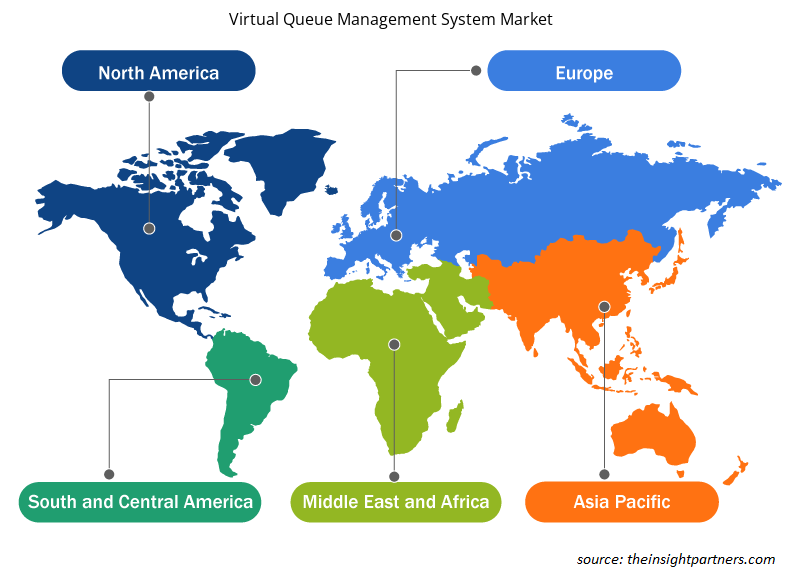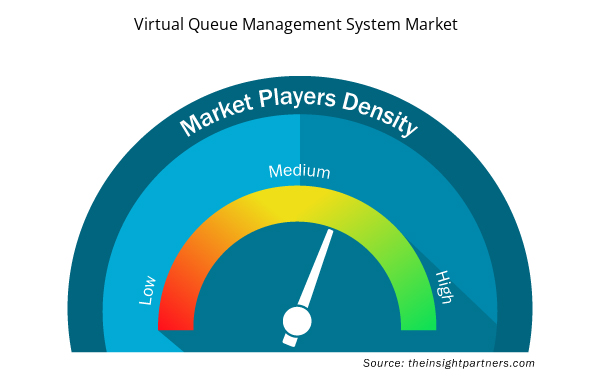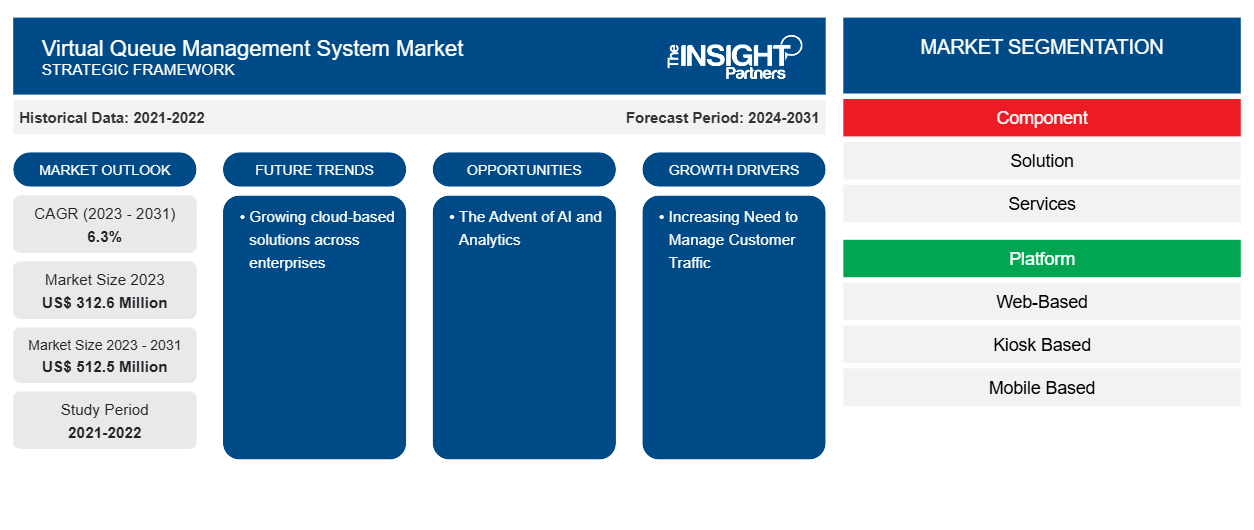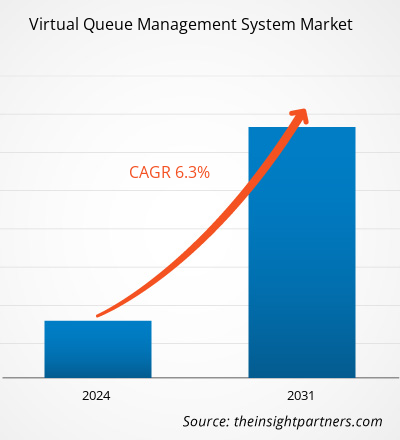仮想キュー管理システムの市場規模は、2023 年の 3 億 1,260 万米ドルから 2031 年には 5 億 1,250 万米ドルに達すると予測されています。市場は 2023 年から 2031 年にかけて 6.3% の CAGR を記録すると予想されています。企業全体でクラウドベースのソリューションが拡大することは、市場の主要なトレンドであり続けると思われます。
仮想キュー管理システム市場分析
仮想キュー管理により、顧客満足度の向上、コミュニケーションの合理化、顧客フローの強化、待ち時間の短縮が実現します。仮想キュー システムを使用する企業は、より多くのクライアントに対応することもできます。仮想キュー システムにより、空港の乗客交通の管理が向上します。これにより、混雑を回避し、チェックイン、セキュリティ チェック、搭乗などのアクティビティ間の移行がスムーズになります。
仮想キュー管理システム市場の概要
仮想キューイング ソリューションは、物理的なキューを最小化または排除し、顧客が列に並んで待つ時間を短縮します。仮想キューはリアルタイムで更新を提供し、顧客に自分の位置を知らせ、全体的なエクスペリエンスを向上させます。仮想キュー管理ソリューションは、追加の人件費を削減し、リソースが効果的に配置されるようにします。仮想キュー管理システムは、サービス ニーズに基づいて顧客を適切なキューにインテリジェントに誘導できるという利点もあります。顧客が誤って間違ったキューを選択した場合は、すぐに変更できます。
要件に合わせてレポートをカスタマイズする
このレポートの一部、国レベルの分析、Excelデータパックなど、あらゆるレポートを無料でカスタマイズできます。また、スタートアップや大学向けのお得なオファーや割引もご利用いただけます。
- このレポートの主要な市場動向を入手してください。この無料サンプルには、市場動向から見積もりや予測に至るまでのデータ分析が含まれます。
仮想キュー管理システム市場の推進要因と機会
市場を有利にするために顧客トラフィックを管理する必要性が高まっている
消費者のトラフィックを監視することは、ビジネスのパフォーマンスにとって重要です。トラフィック分析は、クライアントの行動と習慣を追跡すると同時に、その意味を解釈します。消費者のトラフィックを監視することには、いくつかの利点があります。セキュリティの面では、顧客の活動を追跡し、場所の最も頻繁に訪れるセクションを特定することで、特定のエリアが混雑するのを防ぐことができます。さらに、トラフィック監視により、これらの場所が安全であり、不適切な人物がアクセスできないようにすることができます。トラフィック監視は、金融機関、小売店、病院、政府機関の建物、オフィスビル、キャンパス、倉庫など、さまざまなビジネスで使用できます。消費者のトラフィックを監視することで、ショッピング体験や安全な施設への入場が過度の行列のために不当に遅れることがないようにすることもできます。監視活動から得られるデータにより、ビジネスオーナーはどのエリアが最も人気があるかをしっかりと把握し、それを有利に活用して適切に準備することができます。このように、顧客トラフィックを管理する必要性が高まり、市場の成長を促進しています。
AIと分析の到来。
小売業者がオムニチャネル戦略を採用するケースが増えているため、AI キュー管理テクノロジーは、オンラインと物理的なやり取りを結び付ける上で重要な役割を果たしています。顧客は店舗のアプリを使用してキューの長さをリアルタイムで確認し、参加するか、待ち時間を避けるためにスロットを予約するかを決定できます。このシームレスな統合により、消費者の満足度と忠誠心が向上します。さらに、AI を使用してキューでの消費者の待ち時間を予測できます。顧客は、サービスを受けるためにどれくらい待たなければならないかをリアルタイムで確認できます。これにより、顧客は旅行を計画し、過度の待ち時間を避け、混雑していないときに後で戻ってくることを決定できます。この情報がオンラインで提供されると、待ち時間が最も短いときに到着することを選択できます。これは、需要を平準化し、リソースをより有効に活用することで、ビジネスにもメリットをもたらします。AI は、待機中の顧客の優先順位付けに役立ちます。つまり、特定の時間までに銀行預金をする必要がある顧客や旅行に遅れている顧客など、緊急の要求がある顧客は、それほど緊急ではない顧客よりも先にサービスを受ける可能性があります。これにより、誰もひどい結果に陥ってサービスを受けられないことがなくなります。
仮想キュー管理システム市場レポートのセグメンテーション分析
仮想キュー管理システム市場分析の導出に貢献した主要なセグメントは、コンポーネント、プラットフォーム、およびエンドユーザーです。
- コンポーネントに基づいて、仮想キュー管理システム市場はソリューションとサービスに分類されます。
- プラットフォーム別に見ると、市場は Web ベース、キオスク ベース、モバイル ベースに分類されます。
- 組織の規模によって、市場は中小企業と大企業に分類されます。
- エンドユーザーの観点から見ると、市場は小売店、病院・診療所、空港、博物館・図書館、その他に分類されます。
仮想キュー管理システムの地域別市場シェア分析
仮想キュー管理システム市場レポートの地理的範囲は、主に北米、アジア太平洋、ヨーロッパ、中東およびアフリカ、南米および中米の 5 つの地域に分かれています。北米は技術的に先進的な地域です。この地域では、さまざまなデジタル ソリューションがますます導入されています。さらに、IT 大手の存在が市場の成長を牽引しています。仮想キュー手順は、人々が列に並んで待つ方法を根本的に変え、消費者体験を劇的に向上させます。顧客はどこからでも携帯電話でチェックインし、待ち時間を表示し、直接関わらなくてもサービス メンバーに連絡できるため、仮想キュー管理の採用が拡大しています。
仮想キュー管理システム市場の地域別洞察
予測期間を通じて仮想キュー管理システム市場に影響を与える地域的な傾向と要因は、Insight Partners のアナリストによって徹底的に説明されています。このセクションでは、北米、ヨーロッパ、アジア太平洋、中東およびアフリカ、南米および中米にわたる仮想キュー管理システム市場のセグメントと地理についても説明します。

- 仮想キュー管理システム市場の地域別データを入手
仮想キュー管理システム市場レポートの範囲
| レポート属性 | 詳細 |
|---|---|
| 2023年の市場規模 | 3億1,260万米ドル |
| 2031年までの市場規模 | 5億1,250万米ドル |
| 世界のCAGR(2023年~2031年) | 6.3% |
| 履歴データ | 2021-2022 |
| 予測期間 | 2024-2031 |
| 対象セグメント | コンポーネント別
|
| 対象地域と国 | 北米
|
| 市場リーダーと主要企業プロフィール |
|
仮想キュー管理システム市場のプレーヤー密度:ビジネスダイナミクスへの影響を理解する
仮想キュー管理システム市場は、消費者の嗜好の変化、技術の進歩、製品の利点に対する認識の高まりなどの要因により、エンドユーザーの需要が高まり、急速に成長しています。需要が高まるにつれて、企業は提供内容を拡大し、消費者のニーズを満たすために革新し、新たなトレンドを活用し、市場の成長をさらに促進しています。
市場プレーヤー密度とは、特定の市場または業界内で活動している企業または会社の分布を指します。これは、特定の市場スペースに、その市場規模または総市場価値に対してどれだけの競合相手 (市場プレーヤー) が存在するかを示します。
仮想キュー管理システム市場で事業を展開している主要企業は次のとおりです。
- アクセステクノロジーグループ
- アドバンテック株式会社
- AKISテクノロジーズ
- eGlobe ITソリューション
- ラヴィ インダストリーズ
- オンボリ
免責事項:上記の企業は、特定の順序でランク付けされていません。

- 仮想キュー管理システム市場のトップキープレーヤーの概要を入手
仮想キュー管理システムの市場ニュースと最近の動向
仮想キュー管理システム市場は、主要な企業出版物、協会データ、データベースを含む一次調査と二次調査後の定性的および定量的データを収集することによって評価されます。仮想キュー管理システム市場におけるいくつかの開発を以下に示します。
- 仮想キュー管理および予約スケジュールシステムのプロバイダーである Lavi Industries の Qtrac は本日、Qtrac NextGen プラットフォームの提供開始を発表しました。Qtrac のキュー管理システムの最新版は、拡張性、安全性、および包括性を備えた改良されたエンタープライズ プラットフォームを企業に提供します。強力なビジネス情報とデジタル マーケティング スキルを組み合わせることで新しい収益源を生み出し、企業は顧客体験を向上させると同時に、スタッフのエンゲージメントと生産性を高めることができます。(出典: Qtrac、2021 年 11 月)
- Monta は、EV 充電用の仮想待ち行列システムを導入しました。新しい「スマート キュー」機能により、ドライバーは 1 つ以上の充電ステーションで仮想待ち行列に参加し、充電ポイントが利用可能になったときにすぐに通知を受け取ることができるため、長距離走行中に車両のバッテリーが切れる可能性が低くなります。(出典: Monta、2021 年 10 月)
仮想キュー管理システム市場レポートの対象範囲と成果物
「仮想キュー管理システム市場規模と予測(2021〜2031年)」レポートでは、以下の分野をカバーする市場の詳細な分析を提供しています。
- 仮想キュー管理システムの市場規模と予測(対象範囲に含まれるすべての主要市場セグメントの世界、地域、国レベル)
- 仮想キュー管理システム市場の動向、および推進要因、制約、主要な機会などの市場動向
- 詳細なPEST/ポーターの5つの力とSWOT分析
- 主要な市場動向、世界および地域の枠組み、主要プレーヤー、規制、最近の市場動向を網羅した仮想キュー管理システム市場分析
- 仮想キュー管理システム市場の市場集中、ヒートマップ分析、主要プレーヤー、最近の動向を網羅した業界の状況と競争分析
- 詳細な企業プロフィール
- 過去2年間の分析、基準年、CAGRによる予測(7年間)
- PEST分析とSWOT分析
- 市場規模価値/数量 - 世界、地域、国
- 業界と競争環境
- Excel データセット


- Neurovascular Devices Market
- Single-Use Negative Pressure Wound Therapy Devices Market
- Electronic Toll Collection System Market
- Human Microbiome Market
- Data Center Cooling Market
- Electronic Data Interchange Market
- Smart Water Metering Market
- Military Rubber Tracks Market
- Hydrogen Compressors Market
- Small Internal Combustion Engine Market

Report Coverage
Revenue forecast, Company Analysis, Industry landscape, Growth factors, and Trends

Segment Covered
This text is related
to segments covered.

Regional Scope
North America, Europe, Asia Pacific, Middle East & Africa, South & Central America

Country Scope
This text is related
to country scope.
よくある質問
North America region dominated the virtual queue management system market in 2023.
The increasing need to manage customer traffic is the major factors that propel the global virtual queue management system market.
Growing cloud-based solutions across enterprises to play a significant role in the global virtual queue management system market in the coming years.
The leading players operating in the global virtual queue management system market are Accesso Technology Group, plc, Advantech Co. Ltd., AKIS Technologies, eGlobe IT Solutions, Lavi Industries, Ombori, Queue-it, Qmatic, SEDCO, and Hague Australia.
The global virtual queue management system market is expected to reach US$ 512.5 million by 2031.
The market is expected to register a CAGR of 6.3% during 2023–2031.
Trends and growth analysis reports related to Technology, Media and Telecommunications : READ MORE..
The Insight Partners performs research in 4 major stages: Data Collection & Secondary Research, Primary Research, Data Analysis and Data Triangulation & Final Review.
- Data Collection and Secondary Research:
As a market research and consulting firm operating from a decade, we have published and advised several client across the globe. First step for any study will start with an assessment of currently available data and insights from existing reports. Further, historical and current market information is collected from Investor Presentations, Annual Reports, SEC Filings, etc., and other information related to company’s performance and market positioning are gathered from Paid Databases (Factiva, Hoovers, and Reuters) and various other publications available in public domain.
Several associations trade associates, technical forums, institutes, societies and organization are accessed to gain technical as well as market related insights through their publications such as research papers, blogs and press releases related to the studies are referred to get cues about the market. Further, white papers, journals, magazines, and other news articles published in last 3 years are scrutinized and analyzed to understand the current market trends.
- Primary Research:
The primarily interview analysis comprise of data obtained from industry participants interview and answers to survey questions gathered by in-house primary team.
For primary research, interviews are conducted with industry experts/CEOs/Marketing Managers/VPs/Subject Matter Experts from both demand and supply side to get a 360-degree view of the market. The primary team conducts several interviews based on the complexity of the markets to understand the various market trends and dynamics which makes research more credible and precise.
A typical research interview fulfils the following functions:
- Provides first-hand information on the market size, market trends, growth trends, competitive landscape, and outlook
- Validates and strengthens in-house secondary research findings
- Develops the analysis team’s expertise and market understanding
Primary research involves email interactions and telephone interviews for each market, category, segment, and sub-segment across geographies. The participants who typically take part in such a process include, but are not limited to:
- Industry participants: VPs, business development managers, market intelligence managers and national sales managers
- Outside experts: Valuation experts, research analysts and key opinion leaders specializing in the electronics and semiconductor industry.
Below is the breakup of our primary respondents by company, designation, and region:

Once we receive the confirmation from primary research sources or primary respondents, we finalize the base year market estimation and forecast the data as per the macroeconomic and microeconomic factors assessed during data collection.
- Data Analysis:
Once data is validated through both secondary as well as primary respondents, we finalize the market estimations by hypothesis formulation and factor analysis at regional and country level.
- Macro-Economic Factor Analysis:
We analyse macroeconomic indicators such the gross domestic product (GDP), increase in the demand for goods and services across industries, technological advancement, regional economic growth, governmental policies, the influence of COVID-19, PEST analysis, and other aspects. This analysis aids in setting benchmarks for various nations/regions and approximating market splits. Additionally, the general trend of the aforementioned components aid in determining the market's development possibilities.
- Country Level Data:
Various factors that are especially aligned to the country are taken into account to determine the market size for a certain area and country, including the presence of vendors, such as headquarters and offices, the country's GDP, demand patterns, and industry growth. To comprehend the market dynamics for the nation, a number of growth variables, inhibitors, application areas, and current market trends are researched. The aforementioned elements aid in determining the country's overall market's growth potential.
- Company Profile:
The “Table of Contents” is formulated by listing and analyzing more than 25 - 30 companies operating in the market ecosystem across geographies. However, we profile only 10 companies as a standard practice in our syndicate reports. These 10 companies comprise leading, emerging, and regional players. Nonetheless, our analysis is not restricted to the 10 listed companies, we also analyze other companies present in the market to develop a holistic view and understand the prevailing trends. The “Company Profiles” section in the report covers key facts, business description, products & services, financial information, SWOT analysis, and key developments. The financial information presented is extracted from the annual reports and official documents of the publicly listed companies. Upon collecting the information for the sections of respective companies, we verify them via various primary sources and then compile the data in respective company profiles. The company level information helps us in deriving the base number as well as in forecasting the market size.
- Developing Base Number:
Aggregation of sales statistics (2020-2022) and macro-economic factor, and other secondary and primary research insights are utilized to arrive at base number and related market shares for 2022. The data gaps are identified in this step and relevant market data is analyzed, collected from paid primary interviews or databases. On finalizing the base year market size, forecasts are developed on the basis of macro-economic, industry and market growth factors and company level analysis.
- Data Triangulation and Final Review:
The market findings and base year market size calculations are validated from supply as well as demand side. Demand side validations are based on macro-economic factor analysis and benchmarks for respective regions and countries. In case of supply side validations, revenues of major companies are estimated (in case not available) based on industry benchmark, approximate number of employees, product portfolio, and primary interviews revenues are gathered. Further revenue from target product/service segment is assessed to avoid overshooting of market statistics. In case of heavy deviations between supply and demand side values, all thes steps are repeated to achieve synchronization.
We follow an iterative model, wherein we share our research findings with Subject Matter Experts (SME’s) and Key Opinion Leaders (KOLs) until consensus view of the market is not formulated – this model negates any drastic deviation in the opinions of experts. Only validated and universally acceptable research findings are quoted in our reports.
We have important check points that we use to validate our research findings – which we call – data triangulation, where we validate the information, we generate from secondary sources with primary interviews and then we re-validate with our internal data bases and Subject matter experts. This comprehensive model enables us to deliver high quality, reliable data in shortest possible time.


 このレポートの無料サンプルを入手する
このレポートの無料サンプルを入手する